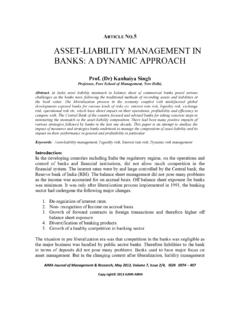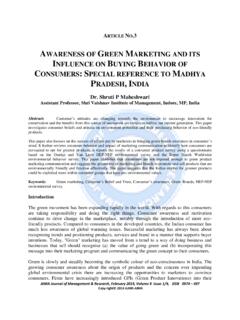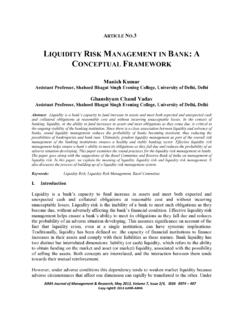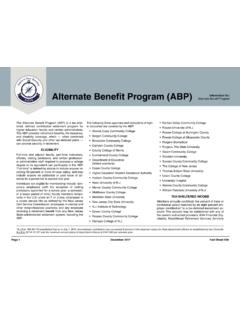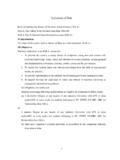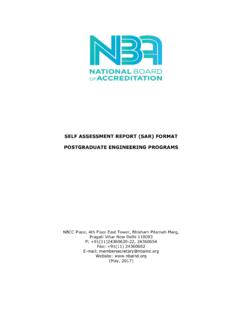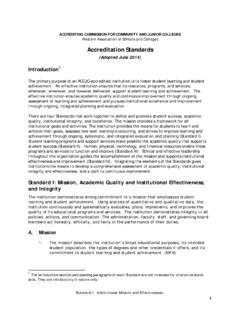Transcription of BASEL I TO BASEL II TO BASEL III: A RISK MANAGEMENT ...
1 AIMA Journal of MANAGEMENT & Research, May 2013, Volume 7, Issue 2/4, ISSN 0974 497 Copy right 2013 AJMR-AIMA ARTICLE BASEL I TO BASEL II TO BASEL III: A RISK MANAGEMENT JOURNEY OF INDIAN BANKS Prof. Debajyoti Ghosh Roy adjunct faculty , Symbiosis School of Banking MANAGEMENT , Pune Kohli Associate Professor, Symbiosis School of Banking MANAGEMENT , Pune Prof. Swati Khatkale Assistant Professor, Symbiosis School of Banking MANAGEMENT , Pune Abstract: Risk and returns are core pillars of Financial System and Banking Industry. Due to basic business of lending & borrowing, banks have credit risk. Similarly due to treasury & investment operations, market risk is inevitable.
2 In 1988, BCBS has introduced first International Standards BASEL 1 to manage Banking Risk with the help of standardized Capital Adequacy Ratio. CRAR ensures minimum capital to cover depositors money from risky assets. But soon after various frauds & system failures, it was found that operational risk is also a major risk. In BASEL 2, apart from inclusion of credit, market and operational risk; flexibility was introduced. BASEL 2 had an array of approaches from basic standardized approaches to advanced approaches to match the risk MANAGEMENT level of banks. In India, RBI has taken conservative approach and maintained even tougher standards than BASEL Norms.
3 To absorb changes, RBI had introduced various approaches gradually in phases. But internationally even BASEL 2 could not prevent Subprime Mortgage Crises and failures like Lehman Brothers. A few of the major problems were high leverage, asset liability mismatch and liquidity crunch. To solve these issues in 2010, BASEL 3 norms were introduced with liquidity Coverage Ratio, Counter Cycle Buffer, Capital Conservation Buffer and Leverage Ratio. This paper shows the journey of Indian Banks from Basel1 to BASEL 3. Key Words: BASEL 1, BASEL 2, Basel3, Risk MANAGEMENT , Capital Adequacy Ratio, Credit Risk, Market Risk, Operational Risk, Liquidity Risk, Counter Cycle Buffer, Leverage Ratio, Capital Conservation Buffer INTRODUCTION: Banks by their very nature of their business attracts several types of risks , viz.
4 , credit risk, market risk (which includes interest rate risk, foreign exchange risk and liquidity risk), operational risk, reputational risk, business risk, strategic risk, systemic risk to cite a few. Banks are exposed to these risks because of the business of banking which they undertake, which is defined in section 5 (b) of the Banking Regulation Act, 1949 as, "banking" means the accepting, for the purpose of lending or investment, of deposits of money from the public, repayable on demand or otherwise, and withdrawal by cheque, draft, order or otherwise. Section 5 (c) further defines, "banking company" means any company which transacts the business of banking in India.
5 This is also called the process of intermediation, which causes to for the above risks to happen. Section 6 (subsections A to O) of the Banking Regulation Act, 1949, AIMA Journal of MANAGEMENT & Research, May 2013, Volume 7, Issue 2/4, ISSN 0974 497 Copy right 2013 AJMR-AIMA further defines the functions of banks, which further exposes the banks to the above risks . We give below the following definitions of the above risks , for our common understanding in the discussions which follows: 1. Credit Risk: Risk that the counterparty will fail to perform or meet the obligation on the agreed terms. The common types of credit risks are: (i) Transaction Risk: Risk relating to specific trade transactions, sectors or groups.
6 (ii) Portfolio Risk: Risk arising from concentrated credits to a particular sector / lending to a few big borrowers/lending to a large group. 2. Market Risk: Market risk is the risk to a bank s financial condition that could result from adverse movements in market price. The types of market risks are: (i) Interest Rate Risk: Risk felt, when changes in the interest rate structure put pressure on the net interest margin of the Bank. The various types of interest rate risks are detailed below: (a) Gap/Mismatch risk: It arises from holding assets and liabilities and off balance sheet items with different principal amounts, maturity dates and re-pricing dates thereby creating exposure to unexpected changes in the level of market interest rates.
7 (b) Basis risk: It is the risk that the Interest rate of different Assets/liabilities and off balance items may change in different magnitude. The degree of basis risk is fairly high in respect of banks that create composite assets out of composite liabilities. (c) Embedded option risk: Option of pre-payment of loan and fore- closure of deposits before their stated maturities constitute embedded option risk (d) Yield curve risk: Movement in yield curve and the impact of that on portfolio values and income. (e) Reprice risk: When assets are sold before maturities. (f) Reinvestment risk: Uncertainty with regard to interest rate at which the future cash flows could be reinvested.
8 (g) Net interest position risk: When banks have more earning assets than paying liabilities, net interest position risk arises in case market interest rates adjust downwards. (ii) Foreign Exchange or Forex Risk: This risk can be classified into three types. (a) Transaction Risk is observed when movements in price of a currency upwards or downwards, result in a loss on a particular transaction. (b) Translation Risk arises due to adverse exchange rate movements and change in the level of investments and borrowings in foreign currency. (c) Country Risk. The buyers are unable to meet the commitment due to restrictions imposed on transfer of funds by the foreign govt.
9 Or regulators. When the transactions are with the foreign govt. the risk is called as Sovereign Risk. AIMA Journal of MANAGEMENT & Research, May 2013, Volume 7, Issue 2/4, ISSN 0974 497 Copy right 2013 AJMR-AIMA (3) Liquidity Risk: Risk arising due to the potential for liabilities to drain from the Bank at a faster rate than assets. Liquidity risk for banks mainly manifests on account of the following: (a) Funding Liquidity Risk the risk that a bank will not be able to meet efficiently the expected and unexpected current and future cash flows and collateral needs without affecting either its daily operations or its financial condition.
10 (b) Market Liquidity Risk the risk that a bank cannot easily offset or eliminate a position at the prevailing market price because of inadequate market depth or market disruption. (4) Operational Risk arises as a result of failure of operating system in the bank due to certain reasons like fraudulent activities, natural disaster, human error, omission or sabotage etc. (5) Systemic Risk is seen when the failure of one financial institution spreads as chain reaction to threaten the financial stability of the financial system as a whole. (6) Business Risk: These are the risks that the bank willingly assumes to create a competitive advantage n add value to its shareholders.
